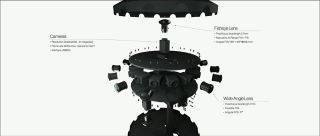Facebook shows off Oculus photo spheres and... VR selfie stick

Facebook just concluded its annual F8 developer conference in San Francisco, with sessions on commerce, monetization… and some other stuff that's not really our wheelhouse. Of substantially more interest are some of the VR demonstrations designed to showcase the scope of the technology. Gaming in VR is just one part of the picture, and as the owner of a pretty big social networking platform, more casual shared experiences are one of Facebook's major goals. And to that end, we bring you… the VR selfie stick.
Okay, before you roll your eyes right out of your head, the 3D photo spheres and virtual interactions shown during the day 2 keynote—which you can watch here, starting at around the 19 minute mark—actually show some promise. In the demonstration, Facebook CTO Mike Schroepfer communicates with Mike Booth, located remotely at Facebook HQ, using an Oculus Rift with Touch controllers. They manipulate objects, pull up 3D photo spheres—recorded using a new VR camera Facebook announced yesterday—and draw ties and other objects for their virtual avatars. Then they snap a virtual photo and are able to drop it into a Facebook post box to instantly share it with their followers.
If anything, watching how this stuff works merely cements our opinion that the Oculus without the Touch controllers is missing a key ingredient to the VR experience.

But let's get back to that VR camera for a moment. Capturing high quality VR video streams is a complex process—you can see the full presentation if you want to know more. In order to achieve the results they wanted, Facebook created a VR camera that consists of 17 individual video cameras, one master camera at the top, with 16 slave cameras (14 around the sides and two on the bottom). These are all operating in sync (genlocked) at 30 or 60 fps.
They call the camera the Surround 360, and it's a video capture system that streams data at around 15-30Gbps (~17Gbps average). To store all the raw data, they're using eight SSDs in RAID0, with the ability to hold up to two hours of continuous video. But they're not done yet!

The final element in the camera is the ability to stitch everything together, which requires a fair amount of compute. I used to like math, until I started seeing equations like the one above. The result is a device that can take all the video sources and stitch them into a wrap-around 2D construct suitable for viewing in VR, in real time.
Facebook will be putting up all the blueprints and source code for their Surround 360 camera on GitHub this summer, for others to use and improve on. Right now, the entire set of equipment costs around $30,000 to build, so the next goal is to take all of this and improve the resolution, shrink the size, improve the quality, and get it to the point where it's all affordable.
PC Gamer Newsletter
Sign up to get the best content of the week, and great gaming deals, as picked by the editors.
Jarred's love of computers dates back to the dark ages when his dad brought home a DOS 2.3 PC and he left his C-64 behind. He eventually built his first custom PC in 1990 with a 286 12MHz, only to discover it was already woefully outdated when Wing Commander was released a few months later. He holds a BS in Computer Science from Brigham Young University and has been working as a tech journalist since 2004, writing for AnandTech, Maximum PC, and PC Gamer. From the first S3 Virge '3D decelerators' to today's GPUs, Jarred keeps up with all the latest graphics trends and is the one to ask about game performance.
Most Popular


